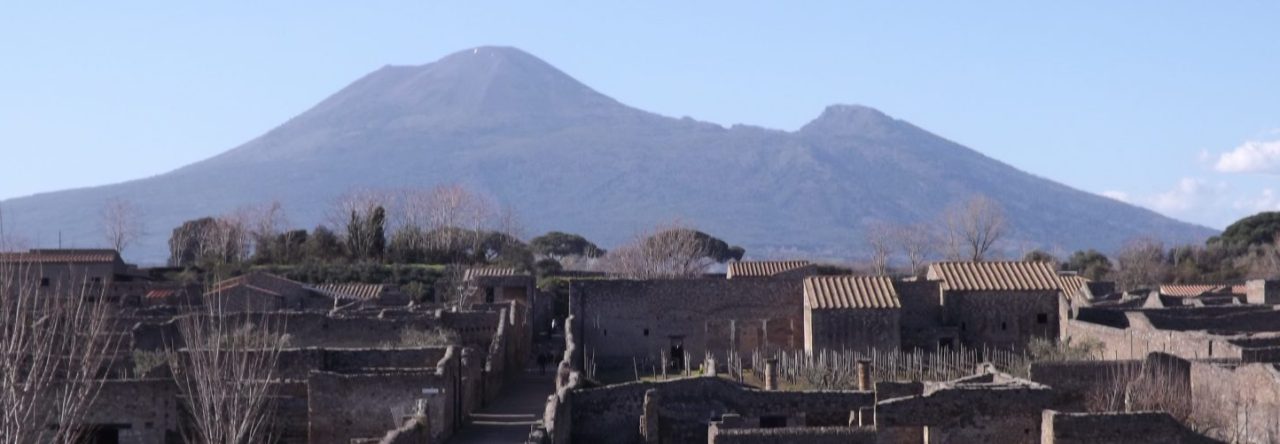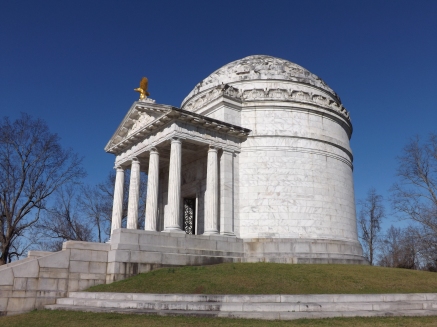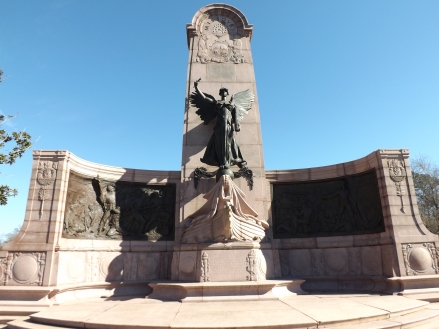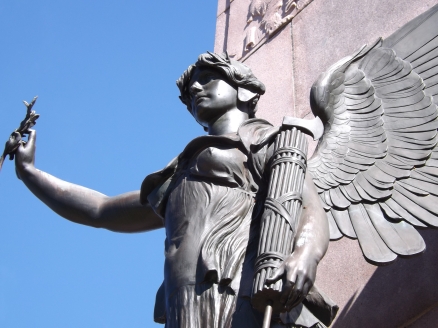With thanks to Will, a lovely park ranger who answered my questions, gave me a fabulous book on Vicksburg’s monuments, and tipped me off to the gastronomic delight that is Mother’s Restaurant in New Orleans.
If there is one period of history other than the Classical world with which I am utterly fascinated, it is the U.S. in the mid-nineteenth century, specifically the Civil War era. As such, when taking a little road trip on my way to New Orleans to attend the annual meetings of the AIA/SCS last week, I couldn’t resist a slight detour to visit the National Military Park at Vicksburg. The city of Vicksburg (if you need a little history lesson), marked the last battle between Union and Confederate forces for control of the Mississippi River, which had, to that point, been an essential conduit for supplies and troops in the Confederate war effort. It is the battle that made General Ulysses S. Grant known to President Lincoln, subsequently leading to his appointment as commander of the entire Union army for the last two years of the war. But more to the point, Vicksburg was a long, hard campaign for both sides, and ended only after the city was besieged by Union forces for more than fifty days in the summer of 1863. (Oddly enough, surrender came within a day of the conclusion of the other truly decisive battle of the war, taking place concurrently in Gettysburg.)
Having lived in the mid-Atlantic region for many years, I have already been to the majority of the Civil War battlefields in Maryland and Virginia, and of course, to Gettysburg. They are all well presented, heartbreaking, and monumental each in their own way. Yet I was wholly unprepared for the sheer beauty of Vicksburg, the manner in which the tragic efforts of approximately 100,000 men have been commemorated, and most surprisingly to me, the fact that so many of the monuments are Classical in style. Indeed, there are so many references to and copies of Classical art and architecture that I could probably write twenty blog posts (don’t worry, I won’t). The Vicksburg Memorial Arch at the entrance to the park resembles a Roman triumphal arch, numerous state monuments are composed of obelisks (New York, Navy Memorial), columns (Louisiana, Wisconsin) or some combination of these devices (North Carolina, Texas, Iowa). A number of states combine the obelisk or column with a bronze sculpture based on a Greek or Roman deity. Michigan‘s statue of the ‘Spirit of Michigan’ is based on Athena Promachos as sculpted in the fifth century BC by Phidias. The ‘Statue of Peace’ at the base of the Minnesota memorial copies the iconography of the Roman goddess Pax. Ohio, the only state that didn’t erect a single monument but a series of them around the park, built a number of small memorials that resemble a temple façade, similar to the aedicula style tomb popular in Roman cities in the first centuries BC and AD. Pennsylvania also built a monument resembling an ancient tomb, choosing a large exedra with a central pillar, with an inscription carved into the rear of the bench that closely resembles the bench tombs, or scholae, that appear in the necropoleis of ancient Pompeii. Clio, the Greek muse of history, is also a popular feature, appearing in conjunction with an obelisk on the Mississippi monument, as well as in the tympanum of the Illinois memorial.
There are two state memorials in particular, however, which were outstanding for their replication of ancient styles. The first, and perhaps most surprising, is the monument constructed by the state of Illinois. As this state contributed the largest number of men to the Vicksburg campaign, more than 36,000, it is not surprising that they also have the largest memorial. What may be more unexpected however, is that the designers of this structure chose to replicate the Pantheon in Rome.
The Pantheon, built in the early second century AD under Hadrian, was intended to honour the gods of Rome. But by the late eighteenth century, pantheon had become a term used to describe a monument to the dead, and thus was viewed as a fitting model by the architect of the memorial, Major William Le Baron Jenney, who stated that he wanted to design ‘not only a grand and imposing commemorative structure worthy of the State of Illinois, but a temple of fame as well, within the walls of which will be preserved in enduring bronze and stone the name of every soldier from Illinois who participated in that memorable and decisive campaign and siege.’ Although a scaled down version of the original Roman temple, this pantheon is similar in proportions, following the alignment and ratio of dimensions as directed in the first century BC books of the architect Vitruvius. Like its model, the roof has an oculus, a coloured marble floor, and a sculptural group in the tympanum. The three marble figures depict Clio, the muse of history, seated between personifications of North and South, recording the names of the dead in a ledger.
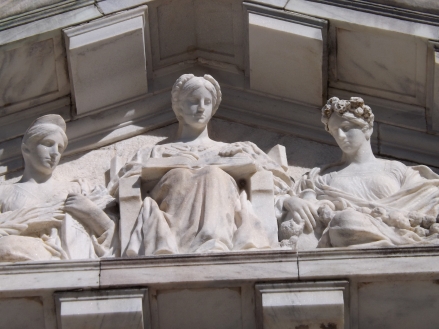
Rather than sculptures of gods placed around the interior of the round chamber, there are sixty bronze plaques affixed to the walls inscribed with the names of the Illinois corps. There are, of course, other elements of decoration that are clearly American in design, such as the large gilded eagle, various symbols of the Republic in the exterior moulding, and an inscription of a quote from Abraham Lincoln’s second inaugural address. However, there is a significant difference in design apart from size, which I find rather interesting: this memorial uses the Doric order in combination with an egg and dart design more commonly found in conjunction with the Ionic order, whereas the capitals of the original Pantheon are Corinthian. This may seem a trifling feature of the design to be concerned with, but it speaks to an overall amalgamation of styles that is typical of the Classically themed structures found in the park.
For a clear example of this, just look to the memorial to Missouri:
Until 2001, this was the only monument that honoured the fighting men of both the Union and Confederate armies, as Missouri was a border state that was divided in its loyalties. It consists of a large stele, fronted by a bronze female figure standing on the prow of a boat, framed by an exedra with bronze reliefs depicting both Union (left) and Confederate (right) soldiers in action. The style is described as Roman composite, but this is not the traditional composite order which combined elements of Ionic and Corinthian style. Instead, it seems to be something of a slightly (at least to the view of a Classicist) muddled combination of elements of both Greek and Roman influence. The stele itself is common enough in both Greece and Rome, found in honorific and commemorative contexts throughout antiquity. And yet the name of the state is written using the Roman letter shapes (specifically ‘V’ instead of ‘U’) and is decorated with egg and dart and dentil mouldings. The exedra is also ubiquitous, as honorific benches also occurred in both places.
The bronze statue, called the ‘Spirit of the Republic’ is based on Nike of Samothrace, the Greek goddess of victory who was depicted landing on the prow of a ship at the moment of victory.
Despite being depicted as entirely Greek in nature, adorned with a peplos and aegis, the two items she holds in her hands are decidedly Roman. In her right hand, she clasps an olive branch. Although the olive itself was closely associated with Athena, it was the Latin poet Vergil with whom the association as a symbol of peace originates:
Aeneid VIII 117 ff.
‘High on the stern Aeneas his stand,
And held a branch of olive in his hand,
While thus he spoke: “The Phrygians’ arms you see,
Expelled from Troy, provoked in Italy
By Latian foes, with war unjustly made;
At first affianced, and at last betrayed.
This message bear: The Trojans and their chief
Bring holy peace, and beg the king’s relief.’
The left hand of the statue contains another Roman symbol, the fasces. This bundle of rods containing an axe was a symbol of political authority, and was carried by lictors who accompanied magistrates through the streets of the city, serving as a sort of bodyguard. Like the statue of Nike, the ‘Spirit of the Republic’ stands on the prow of a ship, to which a battering ram is attached. This was a common feature of ancient naval warfare and cannot be attributed to any one civilisation, although I would note that the shape of it does seem to closely resemble rams recovered from the sea floor near Sicily, the site of a final battle in a Punic War.
What I find fascinating about the design of the state memorials at Vicksburg is not necessarily that they are so heavily influenced by commemorative art and architecture of the Classical world: this is hardly unique in the U.S. (just look to the government buildings in Washington, D.C.), and more to the point, it makes sense to turn to civilisations known for their monumental structures, for honouring their war dead in a grandiose fashion, and perhaps more relevant to this location, suffering the horrors of civil war. The mixing of Greek and Roman styles, the odd combinations of orders, figures, and symbolic elements, however, is striking. To me, this indicates not so much the desire (or dare I say, adequate knowledge) for perfectly replicating Classical architecture, but rather the importance of using a traditional and universally recognised motif that was held in great esteem in order to sufficiently honour those whose dedication and sacrifice are still viewed as being part of the greatest tragedy to befall the U.S.
